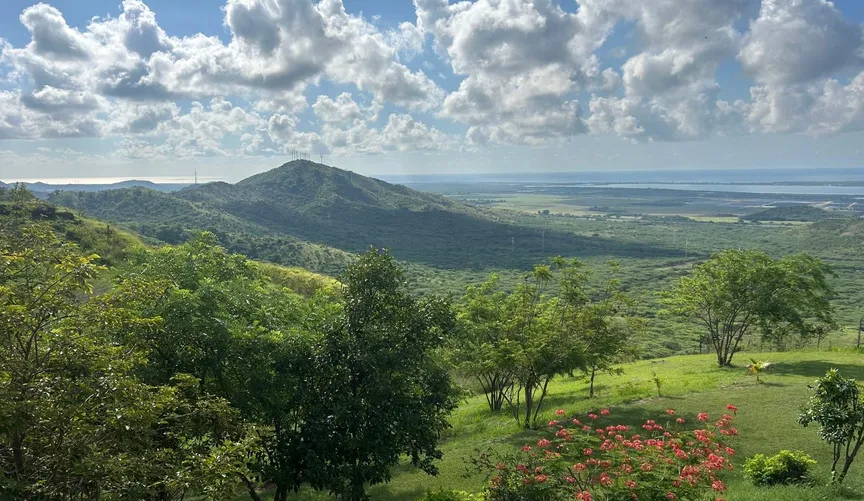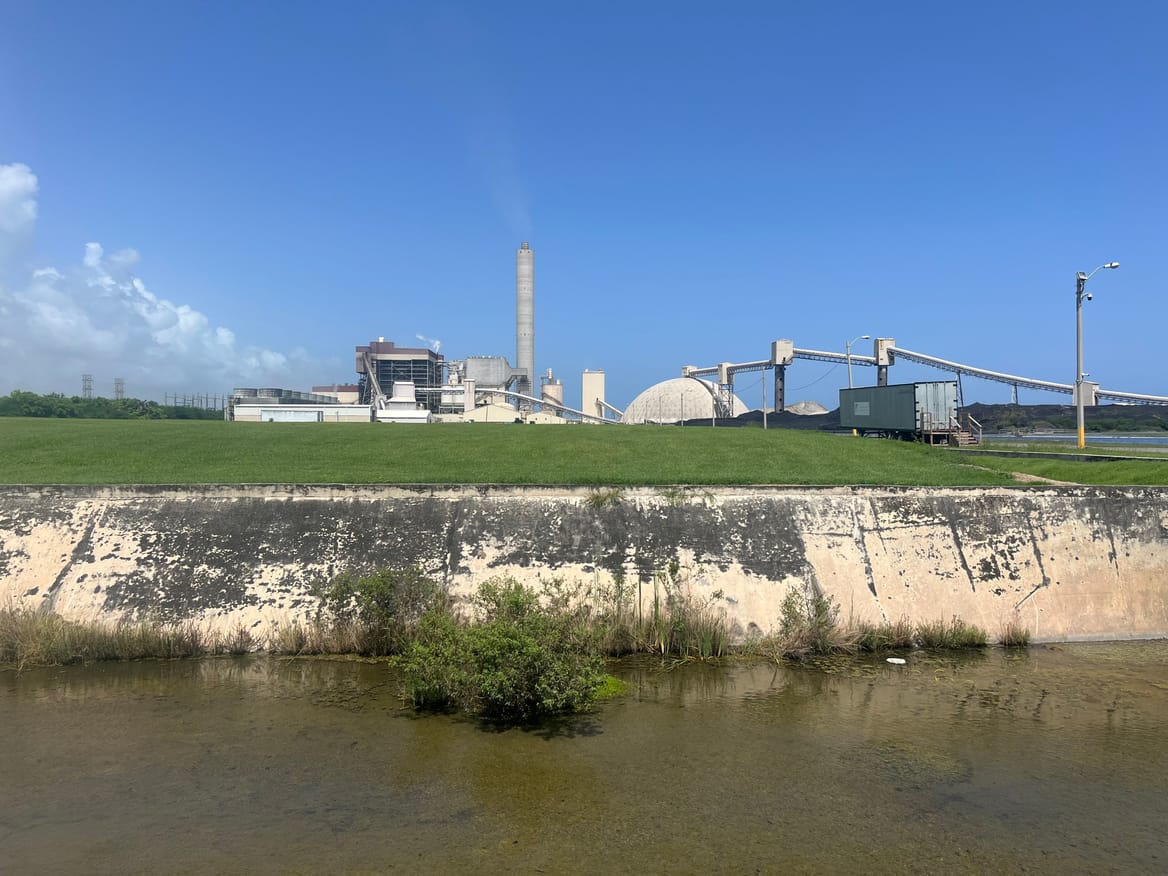
For decades, Puerto Ricans have struggled with a dysfunctional energy system. Now residents are grappling with two very different plans for how to fix it.
President Joe Biden’s administration invested heavily in distributed generation: rooftop solar and battery arrays on homes and businesses across Puerto Rico. But President Donald Trump has rolled back those commitments, redirecting funds toward hardening the grid and shoring up centralized — mostly fossil-fueled — power production.
Energy experts and community leaders say that continued reliance on fossil-fuel power plants is harmful and that sending electricity on transmission lines across rugged mountains plagued by hurricanes is impractical. Distributed generation, they argue, is the best way to supply Puerto Ricans with reliable, affordable power that can withstand natural disasters.
A federal judge’s Oct. 2 ruling on hurricane recovery funds offers a measure of hope to those advocating for this latter vision in the archipelago, which includes the main island and two smaller inhabited islands: Vieques and Culebra.
In September 2017, Hurricanes Irma and Maria battered Puerto Rico in quick succession, devastating homes and infrastructure and causing the lengthiest blackout in U.S. history, leaving some households without power for over a year. The Federal Emergency Management Agency is tasked with rebuilding the island’s energy infrastructure, which still has frequent outages. In 2020, the first Trump administration awarded $9.6 billion for this purpose, and other federal grants bring the pot of FEMA recovery funds for the energy system to over $12 billion.
In its 2020 grid-rebuilding study, FEMA proposed to fix and harden the existing grid and repair fossil-fuel plants. The agency made only cursory mention of distributed solar as supplemental power at critical facilities.
Community groups argued in official comments that instead of rebuilding a grid that has proved vulnerable to disaster, the agency should use federal funds for distributed solar paired with batteries. That would give homes, businesses, hospitals, and schools dependable power even when the grid goes down. FEMA did not incorporate that feedback into its final proposal in 2021, so in April 2023 the community groups, plus the national conservation organization Center for Biological Diversity, filed a lawsuit alleging that FEMA had violated the law by failing to study the environmental impacts of its plan or to consider other alternatives.
Federal Judge Jay A. García-Gregory ruled in the plaintiffs’ favor this October, sending FEMA back to the drawing board to fully study the impacts of various grid-overhaul alternatives, including one based on distributed solar.
“This is a pretty good outcome, an order from a federal district judge requiring FEMA to consider distributed renewable energy for all of this historic amount of funding,” said Ruth Santiago, an environmental attorney who grew up and lives in Salinas, a coastal fishing town located near an oil-fired and a coal-burning power plant.
Under the National Environmental Policy Act (NEPA), before undertaking any project that could significantly affect the “human environment,” a federal agency must release an environmental impact statement after studying the direct and indirect effects the project would have, as well as its cumulative effects with other existing or planned developments. The agency also must take a “hard look” at alternative ways to achieve the same goals.
FEMA argued that its grid-rebuilding plans would not have a significant impact, therefore an in-depth study wasn’t required.
But in their lawsuit, the community groups argued that the impact of FEMA’s rebuilding plans would indeed be massive, and that the agency failed “to engage in meaningful analysis of the environmental effects” of its rebuilding plans.
The judge agreed and ordered FEMA to study the impacts of its plans as well as the alternatives the community groups had proposed: rooftop solar, microgrids that can be disconnected from the main grid in case of a larger outage, and incentives for energy efficiency and power use at times of lower demand.
It’s a measured victory though: FEMA can appeal the decision, take months or years to do the study, and even ignore its own environmental impact statement, as the agency isn’t required to take any action based on its findings.
“If they do an environmental impact statement, it doesn’t mean they will adopt distributed renewable energy options,” said Alfredo Vivioni, a member of the board of directors of the community organization Frente Unido Pro-Defensa del Valle de Lajas (United Front for the Defense of the Lajas Valley), one of the plaintiffs in the lawsuit. “But at least it requires them to make a deeper evaluation of the variables.”
Meanwhile, Trump has threatened to eliminate FEMA altogether, and he has long been skeptical of efforts to mitigate and prepare for climate change.
“When you have a president that says climate change is a hoax, this is going to be interesting,” Vivioni said. “It could also be sad. But you learn to fight and keep on going. You build stamina for this.”
Rebuilding Puerto Rico’s electricity system is a challenge with very high stakes.
More than 4,000 Puerto Ricans died as a result of Hurricane Maria. Lack of electricity was a contributing factor, since residents could not refrigerate medicine or run medical equipment, and ailing people sweltered in high heat and humidity without air conditioning. The Centro de Periodismo Investigativo (Center for Investigative Journalism) in Puerto Rico told the stories of 166 people who died specifically from a lack of electricity.
Advocates for distributed power warn that more fatalities are likely if residents aren’t equipped with solar and batteries to survive future natural disasters. Meanwhile, residents — particularly those on the south coast of the main island — suffer health effects from fossil-fuel generation, and the continued reliance on fossil fuels will contribute to the very climate change–related events that damage the grid and endanger electricity supply, as the community groups pointed out in their lawsuit.
Perpetuating the existing energy system would be an environmental injustice, they argue, since the coal and oil plants on the south coast are located amid some of the island’s poorest communities.
They point to studies showing it is possible to power Puerto Rico with distributed solar while phasing out centralized fossil-fuel plants.
The groups’ lawsuit cites a 2020 National Renewable Energy Laboratory report that found distributed solar could generate more power than the archipelago needs. And it notes that a 2021 Cambio PR and Institute for Energy Economics and Financial Analysis (IEEFA) study found that by 2035, operating a system relying on 75% distributed generation — including rooftop solar, batteries, and microgrids — would be less expensive than operating the current grid, measured in the price of energy per kilowatt-hour.
Rooftop solar paired with batteries, sometimes networked among houses and businesses into microgrids and virtual power plants, has already been invaluable for many Puerto Ricans. Grassroots organizations, tapping federal and philanthropic funds, have installed rooftop solar in communities across the island, as Canary Media chronicled in a 2022 special reporting project.
Biden Energy Secretary Jennifer Granholm touted distributed solar during multiple visits to Puerto Rico, and Biden EPA Administrator Michael Regan talked with residents about the burden of coal power. In December 2022, Biden signed a funding omnibus bill including $1 billion for rooftop solar for low-income households and households with disabilities in Puerto Rico.
As of June 2025, 1.2 gigawatts of grid-connected rooftop solar were installed on homes and businesses, according to the IEEFA, supplying more than 10% of the total energy used.
But the need for more distributed solar is still great. The IEEFA determined that at least 350,000 low- and moderate-income households are unlikely to install rooftop solar without financial assistance, based on 2021 data from the National Renewable Energy Laboratory, leaving them vulnerable during storms.
The Trump administration has gutted such assistance. Federal funding for solar in low-income areas nationwide was canceled, over $156 million of which was promised to Puerto Rico. On Oct. 1, the Department of Energy announced $365 million in Biden administration funds for rooftop solar and battery storage will be redirected to “strengthen grid stability and harden critical infrastructure.”
From his hillside porch on Puerto Rico’s south coast, retired sports medicine professor Miguel Rivera can see a coal-fired power plant, an oil-fired power plant, and an increasingly vast expanse of solar panels stretching across the otherwise lush, green landscape. He is among the residents and experts who say distributed generation is the only real solution for Puerto Rico.

As of spring 2024, 235 megawatts of utility-scale solar were deployed in Puerto Rico, and over 800 megawatts’ worth of such contracts were approved and executed by the federal fiscal control board, which oversees Puerto Rico’s financial affairs.
AES Puerto Rico, the company that owns the coal plant, has installed solar farms on the south coast near Rivera’s home, with the 200-megawatt solar project Marahú scheduled to go online this year. While the installations provide clean energy, they pose the same problem as fossil-fuel plants: The electricity they generate needs to be transported on vulnerable long-distance transmission lines. Meanwhile, the solar panels are being built on swaths of flat, fertile land ideal for farming, which is increasingly scarce on the island.
Though FEMA’s previous energy study did not delve into utility-scale solar, beyond backup power at critical facilities, Santiago said its pros and cons must be considered in the new study.
“What the utility-scale projects, whether renewable or fossil, have in common is that they’re very centralized, and they’re concentrated in one place and then depend a lot on high-voltage transmission lines and towers and substations,” said Santiago. “Distributed renewables on rooftops, parking lots, as close as possible to the point of use — avoid what happened with the existing system after Hurricane Maria. It’s so clear that this is a reasonable opportunity that needs to be considered. Otherwise, we will have more loss of life in the next storm.”
On an October Sunday afternoon a few weeks after the judge’s ruling, Rivera drove through the mountains with his wife, Maridalys Nieves, and friends including José Cora, leader of Acción Social y Protección Ambiental (Social Action and Environmental Protection), a grassroots local environmental justice organization.
They pointed out the broken power lines swinging from poles and lines drooping under curtains of green vines. The well-being and safety of residents in small mountain villages is threatened by the deteriorating power lines. Rooftop solar panels paired with batteries could make these locals largely energy self-sufficient.
But given the median household income of under $25,000 a year in the mountainous regions — Jayuya, Orocovis, and Utuado — that the friends drove through that day, it is nearly impossible for many residents to pay for solar. Cora, an IT professional who maintains computer servers, noted that despite his commitment to clean energy, his family can’t afford to install solar and batteries on their own home.
As the car descended down a mountain, Nieves received a social media alert on her phone that many would not have power because of a problem at the coal plant.
Rooftop solar and batteries are the only way to free residents from such frequent occurrences, the friends agreed. They hope FEMA follows the judge’s orders and does a thorough study, and then funds scores of distributed solar arrays as a result.